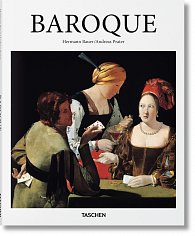From dramatically-lit paintings to elaborate, gilded interiors, the Baroque era introduced a new dimension to Western art. In place of the harmonious perspectives and elegant proportions of the Renaissance came a world of momentum, energy, and heightened spectacle. The style influenced many forms and disciplines between the 16th and 18th century, infusing painting, sculpture, architecture, and music with a direct, often emotive, appeal to the audience. This TASCHEN Basic Art 2.0 edition focuses on Baroque painting. Through mythological and religious scenes, still-lifes, and beyond, we explore how a vivid vocabulary of deep colors, intense shadows, dramatic gestures, and diagonal lines infiltrated both Northern and Southern schools. Along the way, we meet such leading Baroque practitioners as Nicolas Poussin, Annibale Carracci, Caravaggio, Velázquez, Rubens, and Rembrandt, and examine their particular innovations in composition, narrative, and light to achieve a Baroque sensibility.
The authors
Hermann Bauer received his doctorate in 1955 with a thesis on Rocaille. He has taught art history of at Salzburg University and Munich University and has published numerous works on European art of the 16th and 17th century.
Andreas Prater received his doctorate in 1974 on Michelangelo’s Cappella Medicea at Salzburg University. Since 1994, Prater has been professor of history of art at Freiburg University.
The editor
Ingo F. Walther (1940–2007) was born in Berlin and studied medieval studies, literature, and art history in Frankfurt am Main and Munich. He published numerous books on the art of the Middle Ages and of the 19th and 20th centuries. Walther’s many titles for TASCHEN include Vincent van Gogh, Pablo Picasso, Art of the 20th Century, and Codices illustres.




 Když teď objednám,
Když teď objednám, 


































